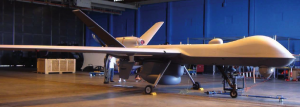 I guess we should be grateful the Customs and Border Patrol simply mismanages its fleet of 9–soon to be 10–drones, each costing $18M apiece. (h/t Kevin Gosztola, who tweeted a report of this) After all, the massive drone that went down in a marsh in Maryland yesterday cost $176M, and it’s surely still burning up.
I guess we should be grateful the Customs and Border Patrol simply mismanages its fleet of 9–soon to be 10–drones, each costing $18M apiece. (h/t Kevin Gosztola, who tweeted a report of this) After all, the massive drone that went down in a marsh in Maryland yesterday cost $176M, and it’s surely still burning up.
But I couldn’t help but think that that money could have been spent on around 3,500 teachers, for a far greater benefit to this country.
The Department of Homeland Security Inspector General says the problem with CPB’s drone program is mismanagement. But that’s mostly because the drones aren’t used as much as the bean counters think they should be–just 29% of the flight hours planned.
CBP has not achieved its scheduled nor desired levels of flight hours of its unmanned aircraft. The Office of Inspector General (OIG) estimates that, based on the contract performance specifications, seven UASs should support 10,662 flight hours per year to meet the mission availability threshold (minimum capability) and 13,328 flight hours to meet the mission availability objective (desired capability). However, resource shortfalls of qualified staff and equipment coupled with restrictions imposed by the Federal Aviation Administration, weather, host airfields, and others have resulted in CBP scheduling just 7,336 flight hours for its seven unmanned aircraft and limited actual flight hours to 3,909 hours. This usage represents 37 percent of the unmanned aircraft’s mission availability threshold and 29 percent of its mission availability objective. Despite the current underutilization of unmanned aircraft, CBP received two additional aircraft in late 2011 and was awaiting delivery of a tenth aircraft in 2012.
Sadly, DHS IG sees this as a management problem, rather than a budgeting and planning problem on the part of DHS management and Congress. And CPB’s response to the IG–basically saying “we’ve got our plan and we’re going to stick to it”–sure sounds like it intends to take delivery of more drones it has neither the equipment, staff, or operational need to use.
As for the massive 44 feet long, 116-foot wingspan, 25,600 pound RQ-4A Global Hawk that went down in Maryland, the most amusing part of the coverage is the number of outlets that report a line from the Navy statements on it, “Crashes are highly unusual, Navy officials said.” The Navy just lost one-fifth of their fleet of this particular drone. I guess losing 20% of your fleet is usual to the Navy.
Popular Mechanics has a short summary explaining why the Navy is making such lame claims about this thing. Not only is Northrop Grumman scheduled to roll out a new maritime version of this to great fanfare on Thursday. But the Senate and Pentagon have noticed that these drones are not actually cheaper than the manned U2 planes the lobbyists were hoping they’d replace.
While the Global Hawk was slated to replace the aging manned U-2 aircraft by 2015, that timetable has been delayed because of the unmanned aircraft’s rising costs. It turns out that it’s cheaper, at least right now, to continue to operate the U-2. And in an age of fiscal austerity, cost matters. The Global Hawk “priced itself out of the niche,” Deputy Secretary of Defense Ashton Carter said earlier this year.
The Pentagon shocked many observers when it decided to scrap plans to replace its U-2 aircraft with a fleet of Global Hawks, effectively sending the unmanned aircraft to an early retirement. The House version of the defense bill tried to keep the program alive, but the Senate last month sided with the Pentagon in its plan to retire the Global Hawk Block 30 aircraft.
Perhaps we’d be better not to compare the cost of the Global Hawk with teachers, as continued funding for it probably threatens Medicare and Social Security more directly.
We can fund the teachers who will teach the next generation of engineers how to avoid such massive cost problems. Or we can hurtle into buying drones that we don’t need and cost more than advertised. One of those plans is already leading to serial failure.